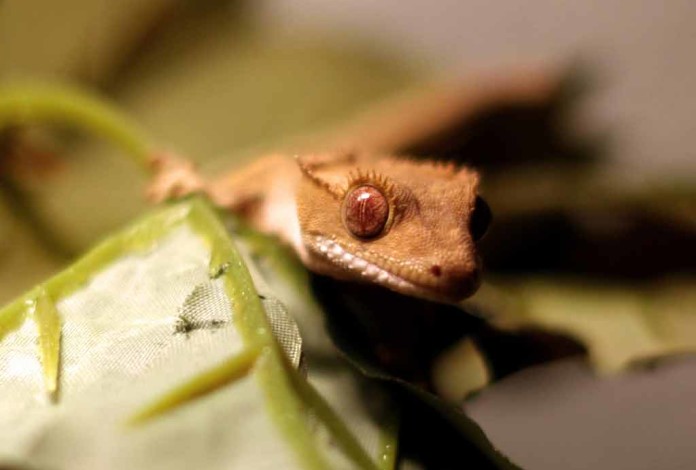Scientific Name: Rhacodactylus ciliatus
Description: The crested gecko is a nocturnal omnivorous reptile that gets its name from the fringe that runs from above its eyes down its back. They are also referred to as the “eyelash gecko” because of this unique cresting.
Distribution: The crested gecko was thought extinct until they were rediscovered in 1994 on the islands of New Caledonia, off the coast of Australia.
 Breeding: This is a relatively easy species to pair up and breed. They should be at least 14-18 months old, healthy and weigh no less than 35 grams. It is important that the female receive sufficient calcium in order to produce the eggs.
Breeding: This is a relatively easy species to pair up and breed. They should be at least 14-18 months old, healthy and weigh no less than 35 grams. It is important that the female receive sufficient calcium in order to produce the eggs.
The gestation period is generally between 30-35 days, at which time the female will produce two eggs. Sperm may remain in the female and fertilize eggs up to eight months after mating.
Size: Hatchlings are 3 inches long, developing into adults ranging from 8-10 inches in length, including the tail.
Life Span: The captive crested gecko can live between 15-20 years if it is cared for properly.
Diet: Omnivorous, the crested gecko feeds on fruits and insects in the wild. In captivity, they can be fed meal replacement powder, live crickets and pureed fruit. They should not be fed citrus fruits, as their digestive system cannot handle the acid. Nutritional supplements of calcium and vitamin D3 should be given at feedings to maintain their health.
Habitat: The crested gecko enjoys climbing, living in the wild on the branches of the lower forest canopy. They require places to hide to make them feel secure. Only one male should be kept in the same enclosure, as they will fight for territory. Two females and one male can be kept in a 29-gallon aquarium.
The crested gecko requires temperatures between 70°F – 80°F. The enclosure should be misted daily to provide hydration and humidity. The crested gecko experiences stress in temperatures below 65°F or above 80°F.
Handling: The crested gecko should be handled carefully and infrequently. When new, they should be given time to acclimate to their environment first. They become stressed very easily. It is best to handle the crested gecko while sitting, since they love to jump. Handle them no more than 15-20 minutes each time.
Crested Geckos as Pets
Find out the reasons why many reptile hobbyists are keeping this reptile as pet.
Caring for the Crestie
Caring of this pet gecko is easily if you follow the guide here.
Crested Gecko Problems
The problems can be minimized if you know how to handle them properly.














